Computational
Geometry
An Introduction Through
Randomized Algorithms
Ketan Mulmuley
�
Computational Geometry
An Introduction Through Randomized
Algorithms
Ketan Mulmuley
The University of Chicago
PRENTICE HALL, Englewood Cliffs, NJ 07632
�
Library of Congress Cataloging-in-Publication Data
Mulmuley, Ketan.
Computational geometry: an introduction through randomized
algorithms / Ketan Mulmuley.
p. cm.
Includes bibliographical references and index.
ISBN 0-13-336363-5
1. Geometry--Data processing. 2. Algorithms. I. Title.
QA448.M85 1994
516'.13--dc2O
93-3138
CIP
Acquisitions editor: BILL ZOBRIST
Production editor: JOE SCORDATO
Copy editor: PETER J. ZURITA
Prepress buyer: LINDA BEHRENS
Manufacturing buyer: DAVID DICKEY
Editorial assistant: DANIELLE ROBINSON
C) 1994 by Prentice-Hall, Inc.
A Simon & Schuster Company
Englewood Cliffs, New Jersey 07632
All rights reserved. No part of this book may be
reproduced, in any form or by any means,
without permission in writing from the publisher.
The author and publisher of this book have used their best efforts in preparing this book. These
efforts include the development, research, and testing of the theories and programs to determine
their effectiveness. The author and publisher make no warranty of any kind, expressed or implied,
with regard to these programs or the documentation contained in this book. The author and
publisher shall not be liable in any event for incidental or consequential damages
in connection with, or arising out of, the furnishing, performance, or use of these programs.
Printed in the United States of America
10 9 8 7 6 5 4 3 2 1
ISBN 0-13-336363-5
Prentice-Hall Intemational (UK) Limited, London
Prentice-Hall of Australia Pty. Limited, Sydney
Prentice-Hall Canada Inc., Toronto
Prentice-Hall Hispanoamericana, S.A., Mexico
Prentice-Hall of India Private Limited, New Delhi
Prentice-Hall of Japan, Inc., Tokyo
Simon & Schuster Asia Pte. Ltd., Singapore
Editora Prentice-Hall do Brasil, Ltda., Rio de Janeiro
�
For Sanchit
�
Contents
Preface
Notation
I Basics
ix
xvi
1
1 Quick-sort and search
.............................
1.1 Quick-sort .........
1.2 Another view of quick-sort . .
1.3 Randomized binary trees ....
3
4
5
7
11
1.3.1 Dynamization ...................................
1.3.2 Another interpretation of rotations ..................... 13
18
.............................................
. . . . . . . . . . . .
. . . . . .
.................................
1.4 Skip lists
2 What is computational geometry?
2.1 Range queries .....
2.2 Arrangements ........................................
2.3 Trapezoidal decompositions
2.4 Convex polytopes ......
.........................................
.............................
....
.....................................
2.4.1 Duality
........................................
2.5 Voronoi diagrams ......................................
2.6 Hidden surface removal . . . . . . . . . . . . . . . . . . . . .
2.7 Numerical precision and degeneracies ......................
2.8 Early deterministic algorithms
...
............
...........................
2.8.1 Planar convex hulls .........................
2.8.2 Arrangements of lines
2.8.3 Trapezoidal decompositions
2.8.4 Planar Voronoi diagrams .....................
2.8.5 Planar point location ........................
. . . . . . . . . . . .
. . . . . . . . . .
.
. . . . .
. . .
. .
2.9 Deterministic vs. randomized algorithms ...................
v
26
28
29
32
36
40
46
51
52
55
56
58
61
67
74
78
�
vi
CONTENTS
2.10 The model of randomness
.....
...............................
78
3 Incremental algorithms
3.1 Trapezoidal decompositions
3.1.1 History . . . . . . . . . . . . . . . . . . . . . . . . . .
..............
3.1.2 Planar graphs ....
3.1.3 Simple polygons* ................................
..............................
...................................
81
84
90
94
94
96
99
....................................... 103
104
106
111
120
.......................
.
.
.
.
.............................
.
.
.
.
.
.
.
.
.
.
.
.
.
.
.
.
.
.
.
.
3.2 Convex polytopes ......................................
......
3.2.1 Conflict maintenance .....
3.2.2 History
3.2.3 On-line linear programming ....
.
.
3.3 Voronoi diagrams .
.
3.4 Configuration spaces .
3.5 Tail estimates*
.
.
.......................................
..
.
.
.
.
.
.
.
.
.
.
.
.
.
.
.
.
.
...
.........................
.............................
126
129
132
135
................................. 137
140
142
149
151
158
162
167
..........................
. .
.
.
.
.
.
.
.
.
.
4 Dynamic algorithms
4.1 Trapezoidal decompositions
...
4.1.1 Point location ..................................
4.2 Voronoi diagrams ...
.....................................
4.2.1 Conflict search .....
4.3 History and configuration spaces
4.3.1 Expected performance*
4.4 Rebuilding history
4.5 Deletions in history ....
....................................
...................................
3D convex polytopes ............................
4.5.1
4.5.2 Trapezoidal decompositions
.
.
.
....................................
.
4.6 Dynamic shuffling
5 Random sampling
5.1 Configuration spaces with bounded valence
.
.
5.2 Top-down sampling
.
5.2.1 Arrangements of lines
.
.
.
.
5.3 Bottom-up sampling ..................................
5.3.1 Point location in arrangements
5.4 Dynamic sampling
....................................
5.4.1 Point location in arrangements
.
.
.
.
.
.
.
.
.
.
.
.
.
....................
................
.
.
.
............................
173
176
181
182
184
185
192
193
................................... 197
.
. 201
204
210
215
221
.
.
.........
.................
...............................
....................
.
.
.
.
.
5.5 Average conflict size
....
5.6 More dynamic algorithms
.
5.6.1 Point location in trapezoidal decompositions
5.6.2 Point location in Voronoi diagrams ..
.
.
.
.
.
.
.
.
.
.
5.7 Range spaces and E-nets .....
5.7.1 VC dimension of a range space .................
�
vii
223
227
CONTENTS
5.8 Comparisons
..........................................
II Applications
6 Arrangements of hyperplanes
Incremental construction .....
6.1
6.2 Zone Theorem .......................................
6.3 Canonical triangulations ...........................
6.3.1 Cutting Lemma ............................
6.4 Point location and ray shooting ......................
6.4.1 Static setting ...............................
6.4.2 Dynamization... ...........................
229
............................... 232
234
238
241
242
242
248
250
253
.. .........................
.. ...........................
6.5 Point location and range queries
6.5.1 Dynamic maintenance
7 Convex polytopes
7.1 Linear programming
7.2 The number of faces
..................................
..................................
7.2.1 Dehn Sommerville relations ...
.......................
7.2.2 Upper bound theorem: Asymptotic form ............
7.2.3 Upper bound theorem: Exact form ..
.................
7.2.4 Cyclic polytopes
................................
Incremental construction .....
7.3.1 Conflicts and linear programming ..................
7.3.2 Conflicts and history ............................
7.3
7.4 The expected structural and conflict change ................
7.5 Dynamic maintenance
.................................
7.6 Voronoi diagrams ..
7.7 Search problems
.....................................
....
......................................
7.7.1 Vertical ray shooting . . . . . . . .
7.7.2 Half-space range queries ..........................
7.7.3 Nearest k-neighbor queries
7.7.4 Dynamization ..................................
..
7.8 Levels and Voronoi diagrams of order k
260
262
267
268
271
271
274
............................... 276
278
279
280
284
285
286
. . . . . . . . . . . 288
289
291
292
294
301
306
...................
.. .........................
........................
7.8.1
7.8.2
Incremental construction
Single level
....................................
8 Range search
8.1 Orthogonal intersection search
. . . . . .
. . . . . . . . . . .
8.1.1 Randomized segment tree
8.1.2 Arbitrary dimension .........................
........................
311
311
312
317
�
viii
CONTENTS
8.2 Nonintersecting segments in the plane .................
8.3 Dynamic point location ......
8.4 Simplex range search .............................
.....................
8.4.1 Partition theorem.
8.4.2 Preprocessing time.....................
....................
8.5 Half-space range queries ...........................
....................
8.5.1 Partition theorem.
8.5.2 Half-space emptiness ........................
8.6 Decomposable search problems ......................
8.6.1 Dynamic range queries .......................
8.7 Parametric search ..
.
.......................
9 Computer graphics
9.1 Hidden surface removal ......
.....................
9.1.1 Analysis.
.
.........................
9.2 Binary Space Partitions ...........................
......................
.....................
.......................
9.2.1 Dimension two.
9.2.2 Dimension three.
.
9.3 Moving viewpoint ..
9.3.1 Construction of a cylindrical partition..........
9.3.2 Randomized incremental construction..........
10 How crucial is randomness?
10.1 Pseudo-random sources ......
10.2 Derandomization ...............................
10.2.1 E-approximations......................
10.2.2 The method of conditional probabilities.........
10.2.3 Divide and conquer .........................
.....................
A Tail estimates
A.1 Chernoff's technique ........................
A.1.1 Binomial distribution...................
A.1.2 Geometric distribution ...................
A.1.3 Harmonic distribution...................
A.2 Chebychev's technique ............................
Bibliography
Index
322
327
328
332
336
338
341
343
345
348
349
358
361
367
372
372
379
383
391
392
398
399
410
412
413
417
422
423
424
426
428
429
431
442
�
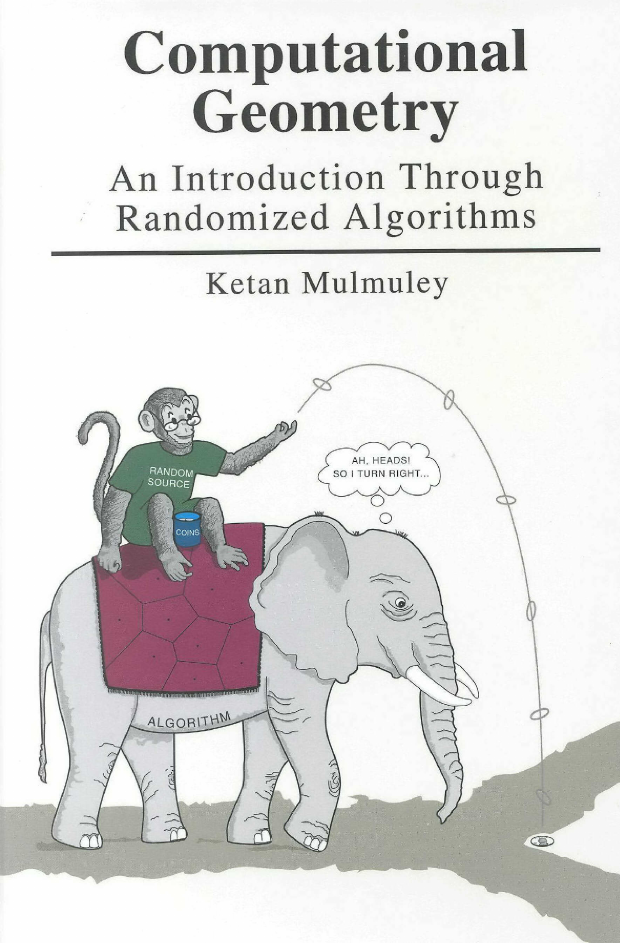

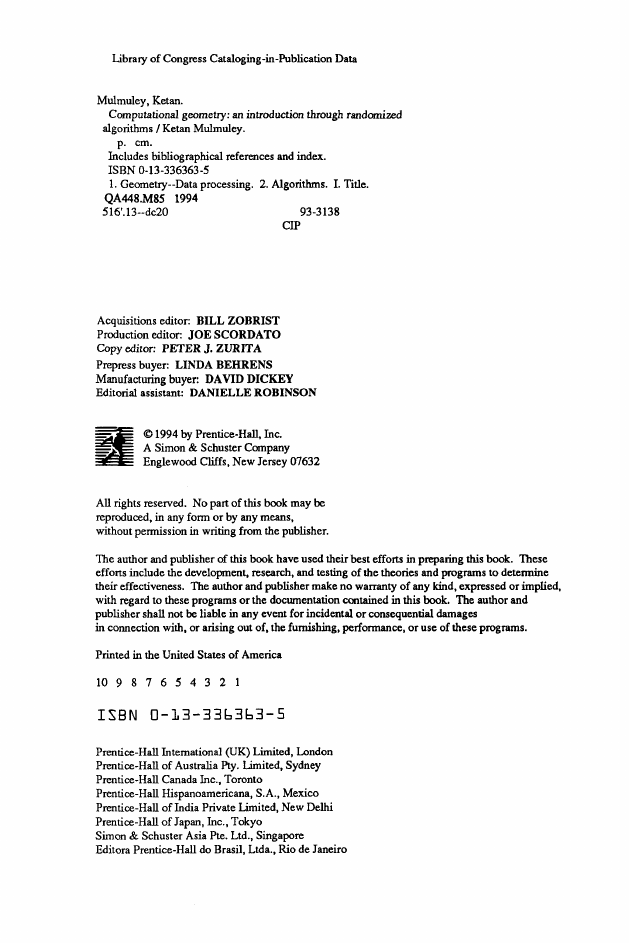

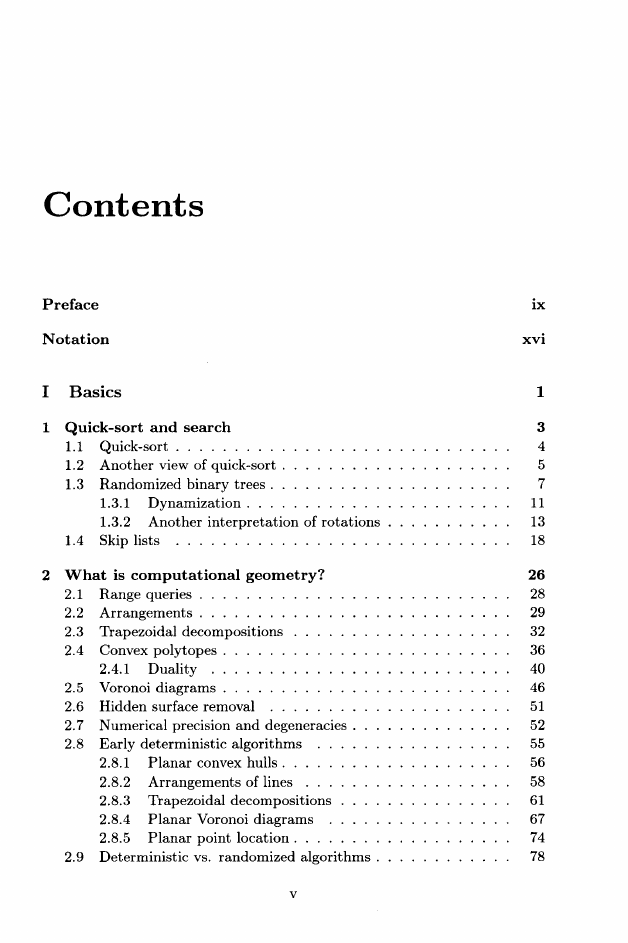
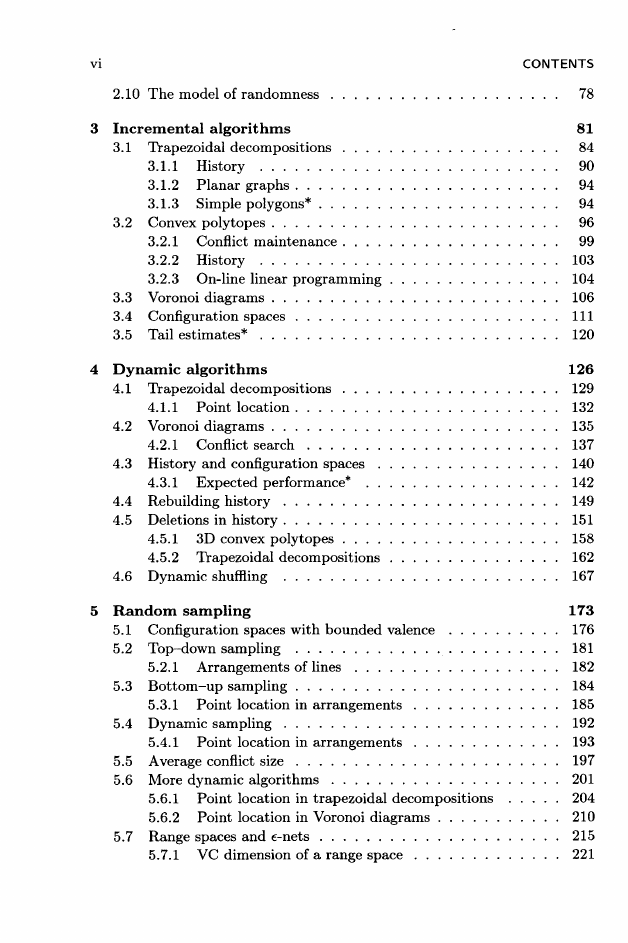
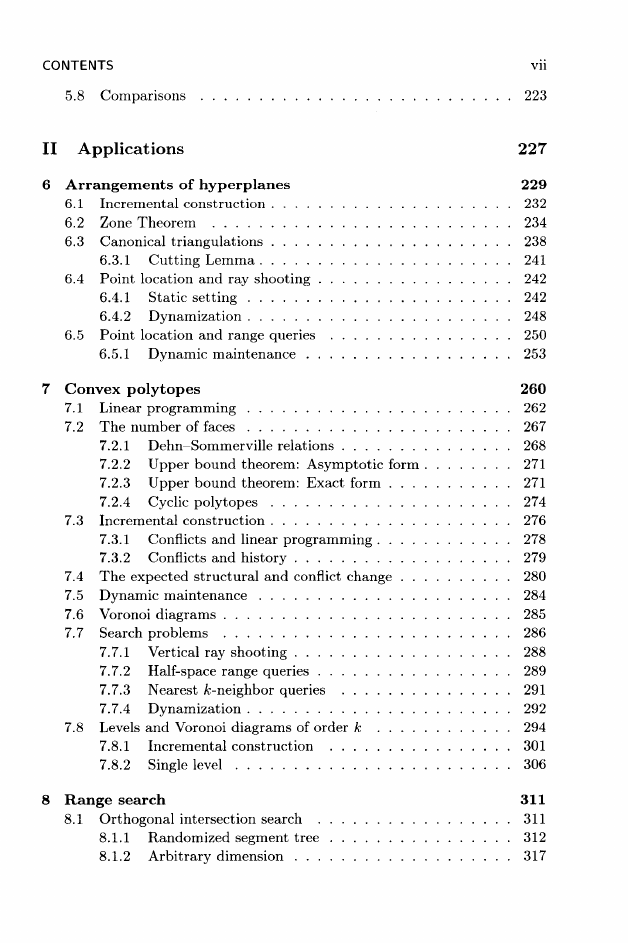
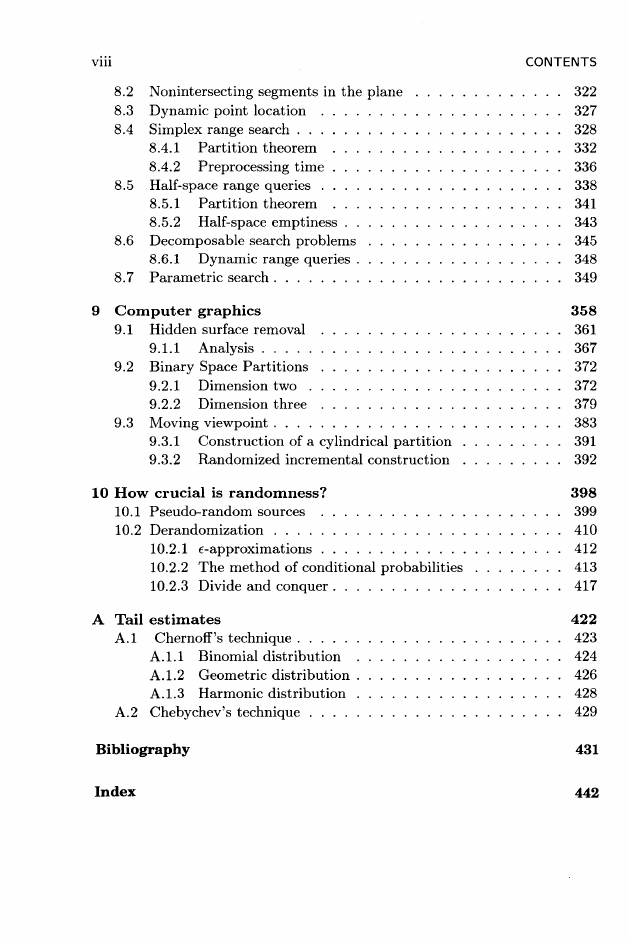








 2023年江西萍乡中考道德与法治真题及答案.doc
2023年江西萍乡中考道德与法治真题及答案.doc 2012年重庆南川中考生物真题及答案.doc
2012年重庆南川中考生物真题及答案.doc 2013年江西师范大学地理学综合及文艺理论基础考研真题.doc
2013年江西师范大学地理学综合及文艺理论基础考研真题.doc 2020年四川甘孜小升初语文真题及答案I卷.doc
2020年四川甘孜小升初语文真题及答案I卷.doc 2020年注册岩土工程师专业基础考试真题及答案.doc
2020年注册岩土工程师专业基础考试真题及答案.doc 2023-2024学年福建省厦门市九年级上学期数学月考试题及答案.doc
2023-2024学年福建省厦门市九年级上学期数学月考试题及答案.doc 2021-2022学年辽宁省沈阳市大东区九年级上学期语文期末试题及答案.doc
2021-2022学年辽宁省沈阳市大东区九年级上学期语文期末试题及答案.doc 2022-2023学年北京东城区初三第一学期物理期末试卷及答案.doc
2022-2023学年北京东城区初三第一学期物理期末试卷及答案.doc 2018上半年江西教师资格初中地理学科知识与教学能力真题及答案.doc
2018上半年江西教师资格初中地理学科知识与教学能力真题及答案.doc 2012年河北国家公务员申论考试真题及答案-省级.doc
2012年河北国家公务员申论考试真题及答案-省级.doc 2020-2021学年江苏省扬州市江都区邵樊片九年级上学期数学第一次质量检测试题及答案.doc
2020-2021学年江苏省扬州市江都区邵樊片九年级上学期数学第一次质量检测试题及答案.doc 2022下半年黑龙江教师资格证中学综合素质真题及答案.doc
2022下半年黑龙江教师资格证中学综合素质真题及答案.doc